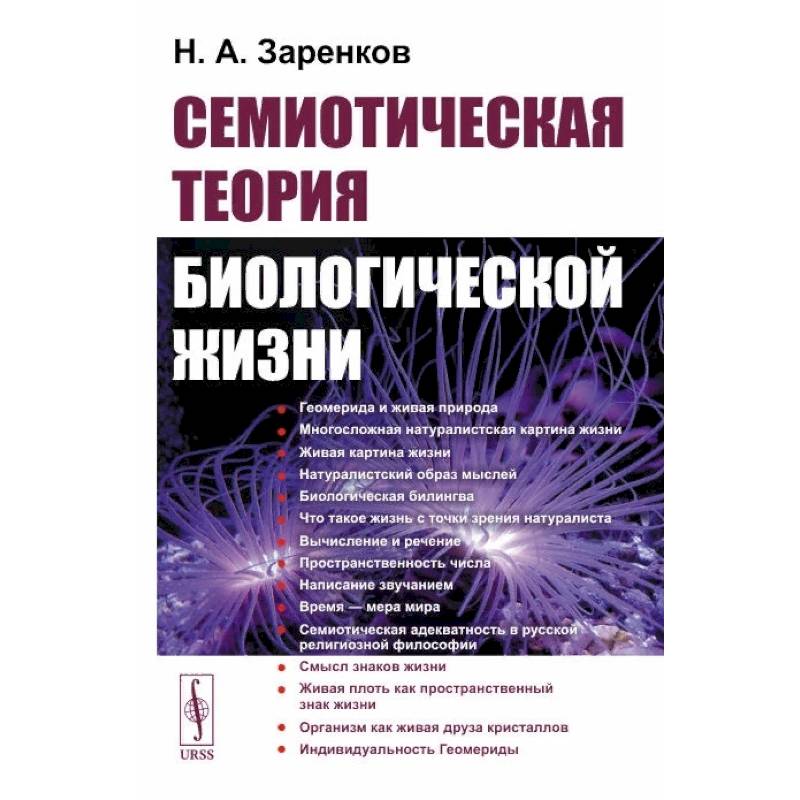Semiotics theory of biological life
Please sign in so that we can notify you about a reply
Is it possible to understand what life is, limited to the study of the flesh of organisms - signs of life: molecules, chromosomes, cells, tissues and organs? This book substantiates a negative answer to this question. The study of living flesh, that is, the substrate of the signs of life, does not bring closer to understanding the so -called essence of life. The essence of life is the meaning and meaning of signs, it has a sign, semiotic nature and belongs to the sphere of ideal. Value exists in interiorganism interactions in the population. In Ch. Darwin, these interactions are called "struggle for life", and the meaning of organism signs-"adaptability". In the texts written by naturalists, natural interiorganism interactions are usually indicated by two triads of logical relations between organisms. Relations that make up the first triad reveal the properties of the flesh of organisms as numbers: similarity (discrete signs in systematics), symmetry (structure plans in biosymmetric), generalized integrity (types of organization in comparative morphophysiology) These three sections of naturalist biology correspond to arithmetic, geometry and algebra, so the living flesh remains the number, which meets the traditions of Pythagorean arithmology. The second triad of relations includes compatibility, coexistence and kinship (affinity) These relationships explain, serve as the cause or condition of the relationship of the first triad: for example, kinship explains the similarity in systematics. Relations of the second triad are distinguished by sections of naturalist biology: Faunity and floristry (compatibility), ecology (coexistence), historical biology (kinship, affinity) These sections of biology meet the components of the triadic meaning of the word: aesthetic (compatibility), ethical (coexistence) and logical (kinship, affinity) The meaning of the number and meaning of the word is reinstalled by interiorganism relations in the formalized concept of geomid.
Together with the concept of the species (population) and the "geometric progression of reproduction", C. Darwin introduced the concept of potentially endless existence and, therefore, the logic of the excluded third. On the example of systematics, the consequences of this circumstance are considered. They are similar to those difficulties in the basics of mathematics, which were caused by the spread of the ideas of G. Kantor. The application of the semiotic approach to the naturalist picture of life is shown. In the light of the principle of Pierre Curie, the specificity of the earthly version of life is discussed on the example of the biological structure of the oceans.
The book is recommended for both specialists - biologists and philosophers, as well as teachers, graduate students and students of biological universities, as well as a wide circle of readers interested in biology
Together with the concept of the species (population) and the "geometric progression of reproduction", C. Darwin introduced the concept of potentially endless existence and, therefore, the logic of the excluded third. On the example of systematics, the consequences of this circumstance are considered. They are similar to those difficulties in the basics of mathematics, which were caused by the spread of the ideas of G. Kantor. The application of the semiotic approach to the naturalist picture of life is shown. In the light of the principle of Pierre Curie, the specificity of the earthly version of life is discussed on the example of the biological structure of the oceans.
The book is recommended for both specialists - biologists and philosophers, as well as teachers, graduate students and students of biological universities, as well as a wide circle of readers interested in biology
Author:
Author:Заренков Н.А.
Cover:
Cover:Soft
Category:
- Category:Science & Math
Publication language:
Publication Language:Russian
Paper:
Paper:printing
ISBN:
ISBN:978-5-9710-9515-6
No reviews found
